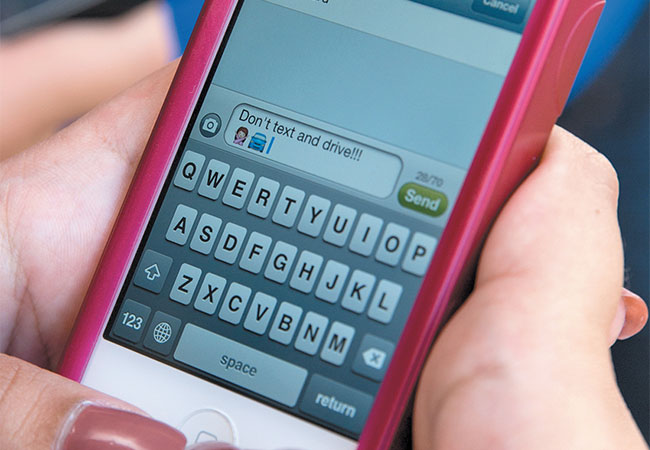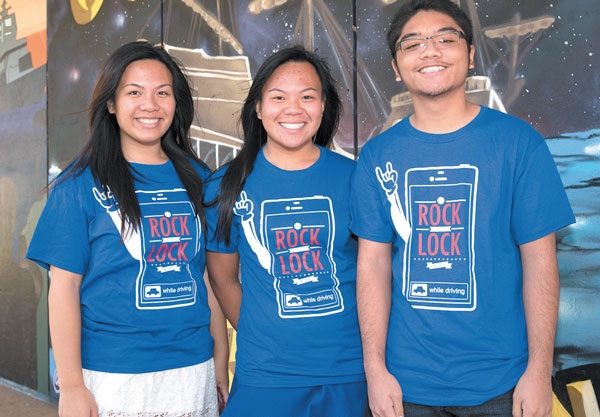Teens Tackle Texting/Driving Carnage
We all have done it.
Even those of you who condemn it have, though you may not like to admit it.
You’re in the car, driving, and you hear that two-tone jingle that is catchier than anything Katy Perry ever wrote.
You glance down to see what your friend just sent you; it’s innocuous enough, he or she is just wondering where you are. Quickly, carefully, you fire back a terse response, just a few words then a stab of the Send button.
Your focus is now back 100 percent on the road, no harm, no foul.
But in the less than 5 seconds it took for that little bit of communication to occur, you will have traveled at highway speeds the entire length of a football field while ostensibly blind.
This is not unique to you. According to the National Occupant Protection Use Survey (NOPUS), at any given daylight moment, 660,000 drivers are using a cell phone or manipulating an electronic device in the U.S. Such use makes the driver 23 times more likely to cause a collision, which leads to an estimated 1.6 million crashes with 421,000 people injured, according to the National Safety Council.
mw-nm-012914-laurenmikichris
Most alarming is the statistic that nearly 50 percent of all U.S. high school students admit to texting or emailing while driving, which the NSC contends is six times more dangerous than driving drunk.
While the state has stiffened its stance on distracted driving, codifying it as a traffic crime that now requires a court appearance even on the first violation, it is our students’ peers who may be best-armed for combating this epidemic.
Last September, four Oahu students were sent by the DOE’s Driver Education Program to Washington, D.C., to attend a youth summit sponsored by the National Organization for Youth Safety. The department paid for the trip on the condition that the students would come home and spread the word about what they learned.
“We saw it as a good opportunity to take the lead on this issue and come back full of ideas of what we could do at our school and in our communities,” says Miki Nishiza-wa, a junior at Waipahu High.
These students from both Campbell and Waipahu high schools came home and or-ganized their own symposium with 170 students from eight schools Nov. 9 at Moanalua High, where they planned a campaign for “Traffic Safety Week.”
Their planning has come to fruition this week (Jan. 27-31) at schools on Oahu, Molokai, Maui and Hawaii Island.
Chris Batoon, a junior at Campbell High, led a presentation at last Novem-ber’s symposium on the guest speakers they had seen at the summit, one of whom was Reggie Shaw, who as a teenager killed a man because Shaw was texting and driving.
“Without the trip to D.C., I would not have known where to start with all this. Now I understand what the consequences of texting and driving are, and what I can do to fight the problem,” says Batoon.
The story of Shaw has helped spread the word on the dangers of driving while distracted, and he has been featured on Oprah and in the powerful documentary film by Werner Herzog, From One Second to the Next.
“It was so powerful because he was sharing his story and people got very emotional; you could tell how much it still impacted him all these years later,” says Nishizawa.
Also at the Moanalua conference, they decided upon a slogan for “Traffic Safety Week,” which is written on an anthropomorphic iPhone, “You Rock if it’s on Lock be safe while Driving.”
This week’s activities will range from morning PSAs and sign-waving to presentations on distracted driving and even a physical distracted-driving test.
On Wednesday at Campbell High, students will be given the opportunity to operate pedal karts through an obstacle course while they are texting their friends. HPD will oversee the event, and they hope to show how distracted one can be while texting, even while operating a simple pedaled vehicle.
Julie and Austin Breitenstein from the Distraction Advocate Network will speak Wednesday at Aiea High, and Thursday at Campbell High. This mother/son duo share the message about how their lives were impacted after Austin sustained a traumatic brain injury from a texting and driving accident. Julie had to leave her job to become a full-time caregiver for her son, as he had to re-learn everything from personal hygiene to how to eat.
Texting is not the only distraction people experience while driving – anything from eating a musubi, messing with the radio or petting a dog on your lap can take your concentration from the road and put you at further risk. Also to be included in “Traffic Safety Week” is a talk on drowsy driving by Kerrie Warne, who lost her son to a crash caused when he fell asleep at the wheel. She will speak at Moanalua Wednesday and at Maui High Friday. This event will also tackle the legal action victims of traffic accidents can take, with the help of local traffic accident lawyers from places like vance law firm so they can get help with their case and their claim.
These risks would seem self-evident, yet 11 teens a day lose their lives in the U.S. because they were driving while distracted.
Why do people believe they are immune?
“They think they are multi-tasking, but they are actually toggling back and forth,” says Tammy Miller, a teacher at Campbell , who accompanied the students on the D.C. trip. “Anytime you go from one to the other, you are missing seconds on the other.”
For Nishizawa, it is as simple as the route you take to school or the way you brush your teeth. Routine can make anything become mundane.
“Texting is just a daily habit. At the conference, we learned that if you are familiar with something, you become so pro at it that you think you can do it anytime, so people just think that it is fine,” says Nishizawa. “Once you do it, it starts to become a habit, and you live off that belief.”
Or die of it.







